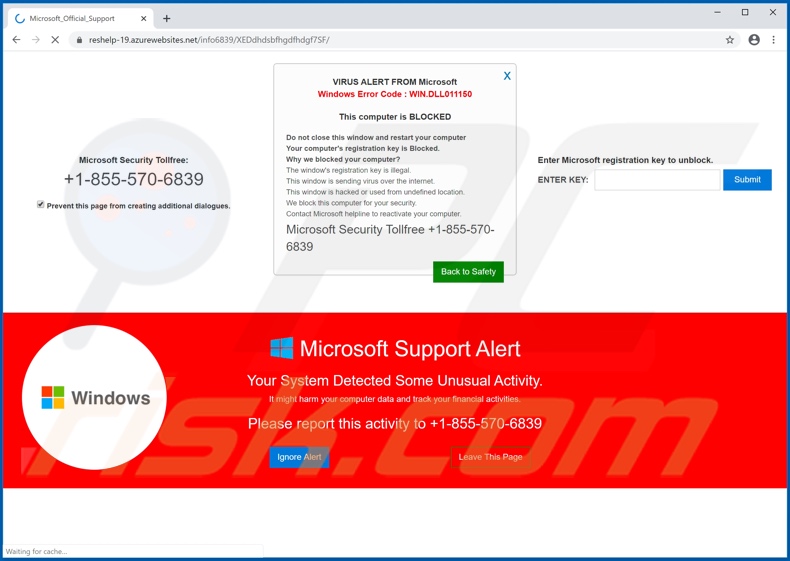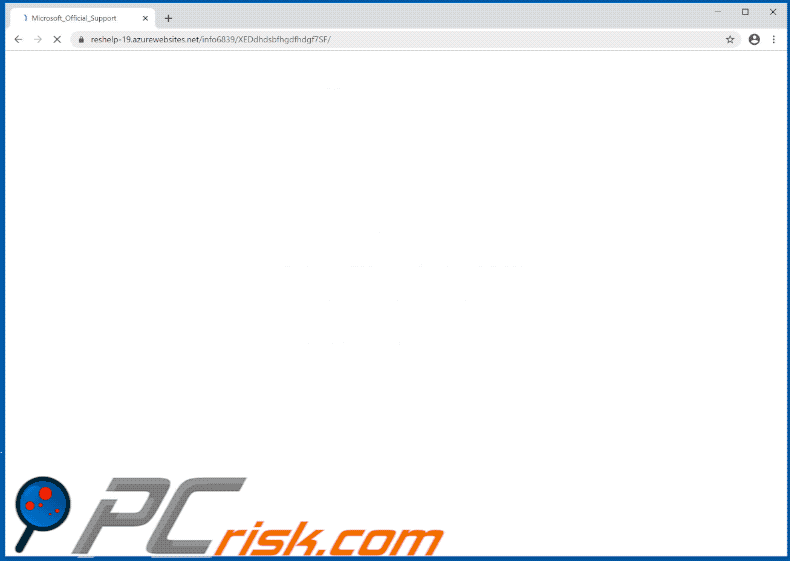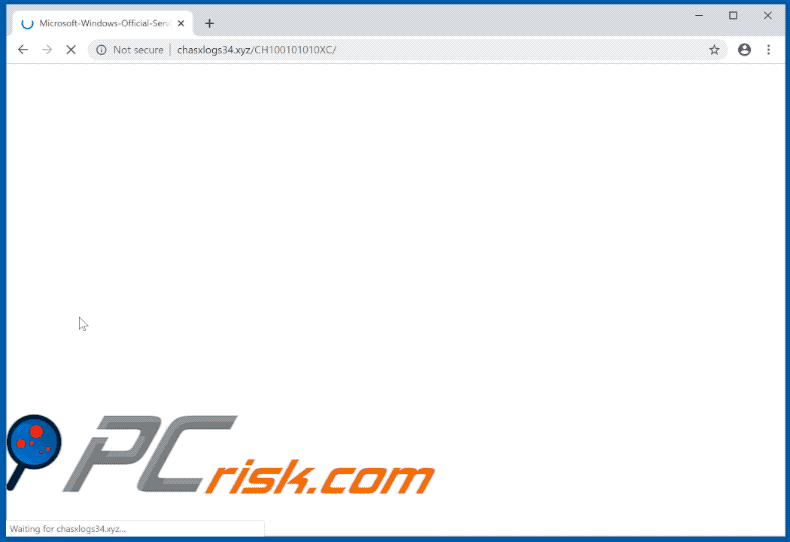Do not trust the "WIN.DLL011150 Error" scam
Phishing/ScamAlso Known As: WIN.DLL011150 Error tech support scam
Get free scan and check if your device is infected.
Remove it nowTo use full-featured product, you have to purchase a license for Combo Cleaner. Seven days free trial available. Combo Cleaner is owned and operated by RCS LT, the parent company of PCRisk.com.
What is the "WIN.DLL011150 Error" scam?
"WIN.DLL011150 Error" is a technical support scam promoted by various deceptive websites. This scheme has been observed being run on azurewebsites.net, though not exclusively. The "WIN.DLL011150 Error" scheme claims that the computer has been blocked due to the Windows registration key supposedly being illegal and the device having been compromised.
This scam attempts to trick people into exposing their registration keys and calling a fake 'tech support' number.
No site can detect threats/issues present on devices - any that make such claims are scams. Users rarely access these deceptive web pages intentionally - most are redirected to them by intrusive advertisements or Potentially Unwanted Applications (PUAs) already infiltrated into the system.

"WIN.DLL011150 Error" scam overview
The pop-up window presented on sites running the "WIN.DLL011150 Error" scam states that it is a "VIRUS ALERT TO Microsoft" with the error code specified as "WIN.DLL01150". Users are warned not to close this web page and/or restart their computers.
Their devices have been allegedly blocked for security reasons, as their Windows registration key have been found to be "illegal". Additionally, a window is supposedly hacked and/or controlled from an unspecified location, and it is proliferating viruses over the internet.
To regain access to their computers, users are urged to call the provided free technical support number and this instruction is repeated several times throughout the deceptive page. Furthermore, the "unusual activity" on the device can apparently pose a threat to stored data and financial activity.
The scheme also instructs users to enter their Microsoft registration key to unblock their computers. Note that all of the information provided by "WIN.DLL011150 Error" is false. Technical support scams are typically used to fool users into calling fake and expensive telephone numbers.
From there on, victims can be held on the line with nonsensical technobabble, while their telephone bill is racking up. Alternatively, the scammers can attempt to extort personal information (e.g. names, addresses, emails, banking account or credit card details, etc.) from users or gain access and control over their devices.
Another way that scammers can abuse users' trust is by requesting payment for "services rendered". In summary, trusting the "WIN.DLL011150 Error" scam can lead to system infections, financial loss, serious privacy issues and even identity theft. In some cases, closing the deceptive web page can be impossible.
In such instances, Task Manager must be used to end the browser process. When the browser is reopened, the previous process must not be restored, as the scam page will then be reopened.
As mentioned, one of the main causes of rogue redirects to untrusted/malicious websites are PUAs, however, these unwanted applications can have other capabilities. They can run ad campaigns (i.e., deliver unwanted and harmful advertisements). When clicked, these intrusive ads redirect to dubious/dangerous sites and can stealthily download/install rogue software (e.g. PUAs).
Another type of PUA can modify browsers, restrict/deny access to settings, and promote fake search engines. Most PUAs have data tracking capabilities. They can record browsing activity (URLs visited, pages viewed, search queries typed, etc.) and gather personal information derived from it (IP addresses, geolocations and other details).
The collected data is often monetized by sharing with third parties (potentially, cyber criminals) seeking to misuse it for profit. These unwanted apps pose a significant threat to device and user safety. Therefore, you are strongly advised to eliminate all suspect applications and browser extensions/plug-in immediately upon detection.
| Name | WIN.DLL011150 Error tech support scam |
| Threat Type | Phishing, Scam, Social Engineering, Fraud. |
| Fake Claim | Scam claims users' devices have been compromised and blocked. |
| Tech Support Scammer Phone Number | +1-855-570-6839 |
| Related Domains | azurewebsites.net, chasxlogs34.xyz |
| Symptoms | Fake error messages, fake system warnings, pop-up errors, hoax computer scan. |
| Distribution methods | Compromised websites, rogue online pop-up ads, potentially unwanted applications. |
| Damage | Loss of sensitive private information, monetary loss, identity theft, possible malware infections. |
| Malware Removal (Windows) |
To eliminate possible malware infections, scan your computer with legitimate antivirus software. Our security researchers recommend using Combo Cleaner. Download Combo CleanerTo use full-featured product, you have to purchase a license for Combo Cleaner. 7 days free trial available. Combo Cleaner is owned and operated by RCS LT, the parent company of PCRisk.com. |
Technical support scam examples
"System Warning Alert", "Activation Security Warning", "Attention 22 threats found" and "ZoneAlarm Global Virus Alert" are some examples of other tech support scams. The Web is rife with various deceptive/scam websites. Technical support schemes are just one type.
Other popular scam models include (but are not limited to) fake prize giveaways, alerts that a piece of essential software is allegedly outdated, "unbelievable" offers/deals, and so on. Scams operate differently (they can make different requests, claims and demands), however, their purpose is identical: to generate revenue for the scammers/cyber criminals behind them.
How did potentially unwanted applications install on my computer?
PUAs are distributed via the download/installation set-ups of other software. This deceptive marketing tactic of pre-packing regular products with unwanted or malicious additions is called "bundling". Rushing downloads/installations (e.g. ignoring terms, skipping steps, using pre-set options, etc.) increases the risk of inadvertent installation of bundled content.
Some PUAs have "official" download web pages. Intrusive ads proliferate these applications as well. Once clicked, they can execute scripts to download/install PUAs without users' consent.
How to avoid installation of potentially unwanted applications
You are advised to research all products before download/installation or purchase. Use only official and verified download channels. Untrusted sources such as unofficial and free file-hosting sites, Peer-to-Peer sharing networks and third party downloaders commonly offer deceptive and/or bundled content.
When downloading/installing, it is important to read the terms, explore all available options, use the "Custom" or "Advanced" settings and opt-out of additional apps, tools, features, etc. Intrusive advertisements may seem legitimate and harmless, however, they can redirect to dubious websites (e.g. gambling, pornography, adult-dating and others).
If you encounter ads/redirects of this kind, check the system and immediately remove all suspicious applications and browser extensions/plug-ins. If your computer is already infected with PUAs, we recommend running a scan with Combo Cleaner Antivirus for Windows to automatically eliminate them.
Text presented in "WIN.DLL011150 Error" scam:
VIRUS ALERT FROM Microsoft
Windows Error Code : WIN.DLL01150
This computer is BLOCKED
Do not close this window and restart your computer
Your computer's registration key is Blocked.
Why we blocked your computer?
The window's registration key is illegal.
This window is sending virus over the internet.
This window is hacked or used from undefined location.
We block this computer your security.
Contact Microsoft helpline to reactivate your computer.
Microsoft Security Tollfree +1-855-570-6839
Back to Safety
Microsoft Security Tollfree:
+1-855-570-6839
Prevent this page from creating additional dialogues.
Enter Microsoft registration key to unblock.
ENTER KEY: Submit
Windows
Microsoft Support Alert
Your System Detected Some Unusual Activity.
It might harm your computer data and track your financial activities.
Please report this activity to +1-855-570-6839
Ignore Alert
Leave This Page
The appearance of "WIN.DLL011150 Error" scam (GIF):

Another variant of "WIN.DLL011150 Error" pop-up scam:

Instant automatic malware removal:
Manual threat removal might be a lengthy and complicated process that requires advanced IT skills. Combo Cleaner is a professional automatic malware removal tool that is recommended to get rid of malware. Download it by clicking the button below:
DOWNLOAD Combo CleanerBy downloading any software listed on this website you agree to our Privacy Policy and Terms of Use. To use full-featured product, you have to purchase a license for Combo Cleaner. 7 days free trial available. Combo Cleaner is owned and operated by RCS LT, the parent company of PCRisk.com.
Quick menu:
- What is WIN.DLL011150 Error tech support scam?
- How to identify a pop-up scam?
- How do pop-up scams work?
- How to remove fake pop-ups?
- How to prevent fake pop-ups?
- What to do if you fell for a pop-up scam?
How to identify a pop-up scam?
Pop-up windows with various fake messages are a common type of lures cybercriminals use. They collect sensitive personal data, trick Internet users into calling fake tech support numbers, subscribe to useless online services, invest in shady cryptocurrency schemes, etc.
While in the majority of cases these pop-ups don't infect users' devices with malware, they can cause direct monetary loss or could result in identity theft.
Cybercriminals strive to create their rogue pop-up windows to look trustworthy, however, scams typically have the following characteristics:
- Spelling mistakes and non-professional images - Closely inspect the information displayed in a pop-up. Spelling mistakes and unprofessional images could be a sign of a scam.
- Sense of urgency - Countdown timer with a couple of minutes on it, asking you to enter your personal information or subscribe to some online service.
- Statements that you won something - If you haven't participated in a lottery, online competition, etc., and you see a pop-up window stating that you won.
- Computer or mobile device scan - A pop-up window that scans your device and informs of detected issues - is undoubtedly a scam; webpages cannot perform such actions.
- Exclusivity - Pop-up windows stating that only you are given secret access to a financial scheme that can quickly make you rich.
Example of a pop-up scam:

How do pop-up scams work?
Cybercriminals and deceptive marketers usually use various advertising networks, search engine poisoning techniques, and shady websites to generate traffic to their pop-ups. Users land on their online lures after clicking on fake download buttons, using a torrent website, or simply clicking on an Internet search engine result.
Based on users' location and device information, they are presented with a scam pop-up. Lures presented in such pop-ups range from get-rich-quick schemes to fake virus scans.
How to remove fake pop-ups?
In most cases, pop-up scams do not infect users' devices with malware. If you encountered a scam pop-up, simply closing it should be enough. In some cases scam, pop-ups may be hard to close; in such cases - close your Internet browser and restart it.
In extremely rare cases, you might need to reset your Internet browser. For this, use our instructions explaining how to reset Internet browser settings.
How to prevent fake pop-ups?
To prevent seeing pop-up scams, you should visit only reputable websites. Torrent, Crack, free online movie streaming, YouTube video download, and other websites of similar reputation commonly redirect Internet users to pop-up scams.
To minimize the risk of encountering pop-up scams, you should keep your Internet browsers up-to-date and use reputable anti-malware application. For this purpose, we recommend Combo Cleaner Antivirus for Windows.
What to do if you fell for a pop-up scam?
This depends on the type of scam that you fell for. Most commonly, pop-up scams try to trick users into sending money, giving away personal information, or giving access to one's device.
- If you sent money to scammers: You should contact your financial institution and explain that you were scammed. If informed promptly, there's a chance to get your money back.
- If you gave away your personal information: You should change your passwords and enable two-factor authentication in all online services that you use. Visit Federal Trade Commission to report identity theft and get personalized recovery steps.
- If you let scammers connect to your device: You should scan your computer with reputable anti-malware (we recommend Combo Cleaner Antivirus for Windows) - cyber criminals could have planted trojans, keyloggers, and other malware, don't use your computer until removing possible threats.
- Help other Internet users: report Internet scams to Federal Trade Commission.
Frequently Asked Questions (FAQ)
What is a pop-up scam?
Basically, a pop-up scam is a deceptive message intended to deceive users into performing certain actions. For example, victims may be lured into calling fake support lines, allowing scammers to access devices remotely, disclosing sensitive information, making monetary transactions, downloading/installing software, buying products, subscribing to services, etc.
What is the purpose of a pop-up scam?
Pop-up scams are designed to generate revenue at victims' expense. Cyber criminals predominantly profit by obtaining funds through deception, promoting content (e.g., websites, software, products, services, etc.), abusing/selling private data, and proliferating malware.
Why do I encounter fake pop-ups?
Pop-up scams are primarily endorsed via websites using rogue advertising networks, intrusive ads (malvertising), spam (e.g., emails, DMs/PMs, SMSes, browser notifications, social media posts, etc.), misspelled URLs (typosquatting), and adware.
I cannot exit a scam page, how do I close it?
If you cannot close a scam webpage – end the browser's process using Task Manager. Remember to start a new browsing session when reaccessing the browser, as restoring the old one will reopen the deceptive site.
I have allowed cyber criminals to remotely access my computer, what should I do?
If you have allowed cyber criminals to access your device remotely – you must first disconnect it from the Internet. Afterward, uninstall the remote access program that the criminals used (e.g., TeamViewer, UltraViewer, etc.), as they might not need your consent to reconnect. Lastly, run a complete system scan with an anti-virus and eliminate all detected threats.
I have provided my personal information when tricked by a pop-up scam, what should I do?
If you have disclosed your log-in credentials – immediately change the passwords of all possibly exposed accounts and inform their official support. And if you've provided other private information (e.g., ID card details, passport scans/photos, credit/debit card numbers, etc.) – contact relevant authorities without delay.
Will Combo Cleaner protect me from pop-up scams and the malware they proliferate?
Combo Cleaner is designed to detect and eliminate all kinds of threats. It is capable of scanning visited websites for rogue, deceptive/scam, and malicious content. Should you happen upon such a webpage – you will be immediately warned, and further access to it will be blocked. Combo Cleaner can also detect and remove almost all known malware infections. It must be stressed that performing a full system scan is essential since high-end malicious software usually hides deep within systems.
Share:

Tomas Meskauskas
Expert security researcher, professional malware analyst
I am passionate about computer security and technology. I have an experience of over 10 years working in various companies related to computer technical issue solving and Internet security. I have been working as an author and editor for pcrisk.com since 2010. Follow me on Twitter and LinkedIn to stay informed about the latest online security threats.
PCrisk security portal is brought by a company RCS LT.
Joined forces of security researchers help educate computer users about the latest online security threats. More information about the company RCS LT.
Our malware removal guides are free. However, if you want to support us you can send us a donation.
DonatePCrisk security portal is brought by a company RCS LT.
Joined forces of security researchers help educate computer users about the latest online security threats. More information about the company RCS LT.
Our malware removal guides are free. However, if you want to support us you can send us a donation.
Donate
▼ Show Discussion